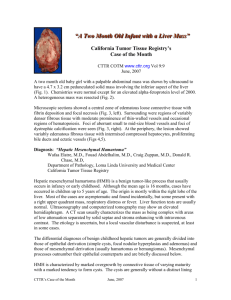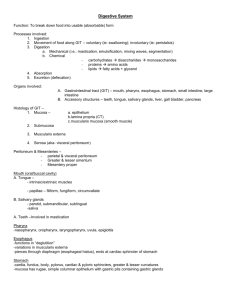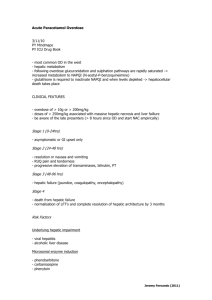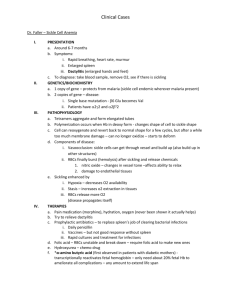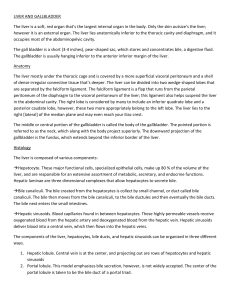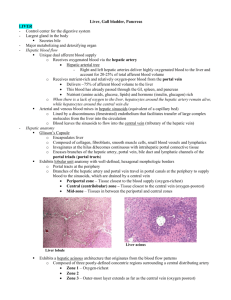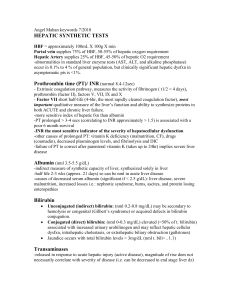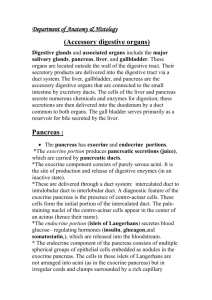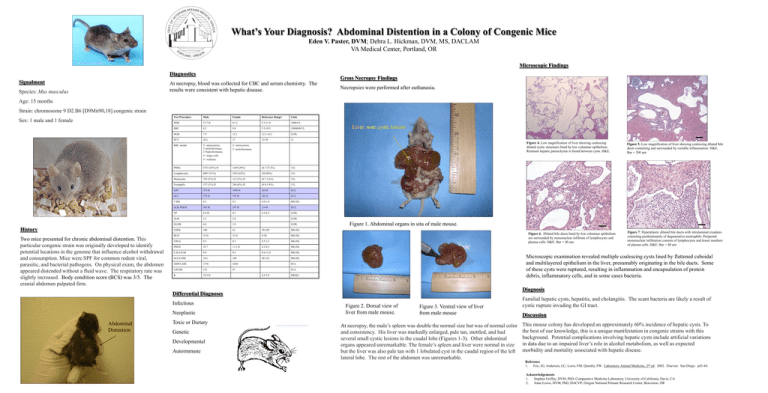
What’s Your Diagnosis? Abdominal Distention in a Colony of Congenic Mice
Eden V. Paster, DVM; Debra L. Hickman, DVM, MS, DACLAM
VA Medical Center, Portland, OR
www.cottontimer.com/2006/08/
Microscopic Findings
Diagnostics
Signalment
Gross Necropsy Findings
At necropsy, blood was collected for CBC and serum chemistry. The
results were consistent with hepatic disease.
Species: Mus musculus
Necropsies were performed after euthanasia.
Age: 15 months
Strain: chromosome 9 D2.B6 [D9Mit90,18] congenic strain
Sex: 1 male and 1 female
www.ornl.gov/.../v37_3_04/article08.shtml
History
Two mice presented for chronic abdominal distention. This
particular congenic strain was originally developed to identify
potential locations in the genome that influence alcohol withdrawal
and consumption. Mice were SPF for common rodent viral,
parasitic, and bacterial pathogens. On physical exam, the abdomen
appeared distended without a fluid wave. The respiratory rate was
slightly increased. Body condition score (BCS) was 3/5. The
cranial abdomen palpated firm.
Test Procedure
Male
Female
Reference Range1
Units
WBC
15.7 H
4.1 L
5.5-11.0
1000/UL
RBC
8.2
9.0
5.5-10.5
1000000/UL
HGB
7.9
12.3
12.2-16.2
G/DL
PCV
26 L
37
33-50
%
RBC morph
3+ anisocytosis,
3+polychromasia,
2+hypochromasia,
3+ target cells
3+ rouleaux
2+ anisocytosis,
2+ polychromasia
PMNs
6751 (43%) H
1189 (29%)
(6.7-37.2%)
/UL
Lymphocytes
8007 (51%)
2542 (62%)
(30-80%)
/UL
Monocytes
785 (5%) H
123 (3%) H
(0.7-2.6%)
/UL
Eosinphils
157 (1%) H
246 (6%) H
(0.9-3.8%)
/UL
AST
374 H
1495 H
10-45
IU/L
ALT
375 H
973 H
10-35
IU/L
T Bili
0.3
0.2
0.0-1.0
MG/DL
ALK PHOS
945 H
297 H
15-45
IU/L
TP
6.9 H
4.7
4.5-6.5
G/DL
ALB
2.5
2.8
G/DL
GLOB
4.4
1.9
G/DL
CHOL
100
62
50-250
MG/DL
BUN
35 H
33 H
9-30
MG/DL
CREA
0.5
0.5
0.5-2.2
MG/DL
PHOS
18.7
11.2 H
4.2-8.5
MG/DL
CALCIUM
9.9
9.3
8.0-12.0
MG/DL
GLUCOSE
10 L
104
60-125
MG/DL
AMYLASE
1576
1020
IU/L
LIPASE
152
47
IU/L
K
10.5 H
Liver: note cystic lesions
Figure 4
Figure 4. Low magnification of liver showing coalescing
dilated cystic structures lined by low columnar epithelium.
Remnant hepatic parenchyma is found between cysts. H&E.
4.3-5.8
Figure 1. Abdominal organs in situ of male mouse.
Figure 6. Dilated bile ducts lined by low columnar epithelium
are surrounded by mononuclear infiltrate of lymphocytes and
plasma cells. H&E. Bar = 40 um.
MEQ/L
Diagnosis
Infectious
Figure 2. Dorsal view of
liver from male mouse.
Neoplastic
Toxic or Dietary
Genetic
Developmental
Autoimmune
www.nal.usda.gov/.../v8n3/8n3mfg1.htm
Figure 7: Hyperplastic dilated bile ducts with intraluminal exudates
consisting predominantly of degenerative neutrophils. Periportal
mononuclear infiltration consists of lymphocytes and lesser numbers
of plasma cells. H&E. Bar = 40 um
Microscopic examination revealed multiple coalescing cysts lined by flattened cuboidal
and multilayered epithelium in the liver, presumably originating in the bile ducts. Some
of these cysts were ruptured, resulting in inflammation and encapsulation of protein
debris, inflammatory cells, and in some cases bacteria.
Differential Diagnoses
Abdominal
Distention
Figure 5. Low magnification of liver showing coalescing dilated bile
ducts containing and surrounded by variable inflammation. H&E.
Bar = 200 um
www.fotosearch.de/ARP112/mouse/
Figure 3. Ventral view of liver
from male mouse
At necropsy, the male’s spleen was double the normal size but was of normal color
and consistency. His liver was markedly enlarged, pale tan, mottled, and had
several small cystic lesions in the caudal lobe (Figures 1-3). Other abdominal
organs appeared unremarkable. The female’s spleen and liver were normal in size
but the liver was also pale tan with 1 lobulated cyst in the caudal region of the left
lateral lobe. The rest of the abdomen was unremarkable.
Familial hepatic cysts, hepatitis, and cholangitis. The scant bacteria are likely a result of
cystic rupture invading the GI tract.
Discussion
This mouse colony has developed an approximately 60% incidence of hepatic cysts. To
the best of our knowledge, this is a unique manifestation in congenic strains with this
background. Potential complications involving hepatic cysts include artificial variations
in data due to an impaired liver’s role in alcohol metabolism, as well as expected
morbidity and mortality associated with hepatic disease.
Reference
1.
Fox, JG; Anderson, LC; Loew, FM; Quimby, FW. Laboratory Animal Medicine, 2nd ed. 2002. Elsevier. San Diego. p43-44.
Acknowledgements
1.
Stephen Griffey, DVM, PhD; Comparative Medicine Laboratory, University of California, Davis, CA
2.
Anne Lewis, DVM, PhD, DACVP; Oregon National Primate Research Center, Beaverton, OR


